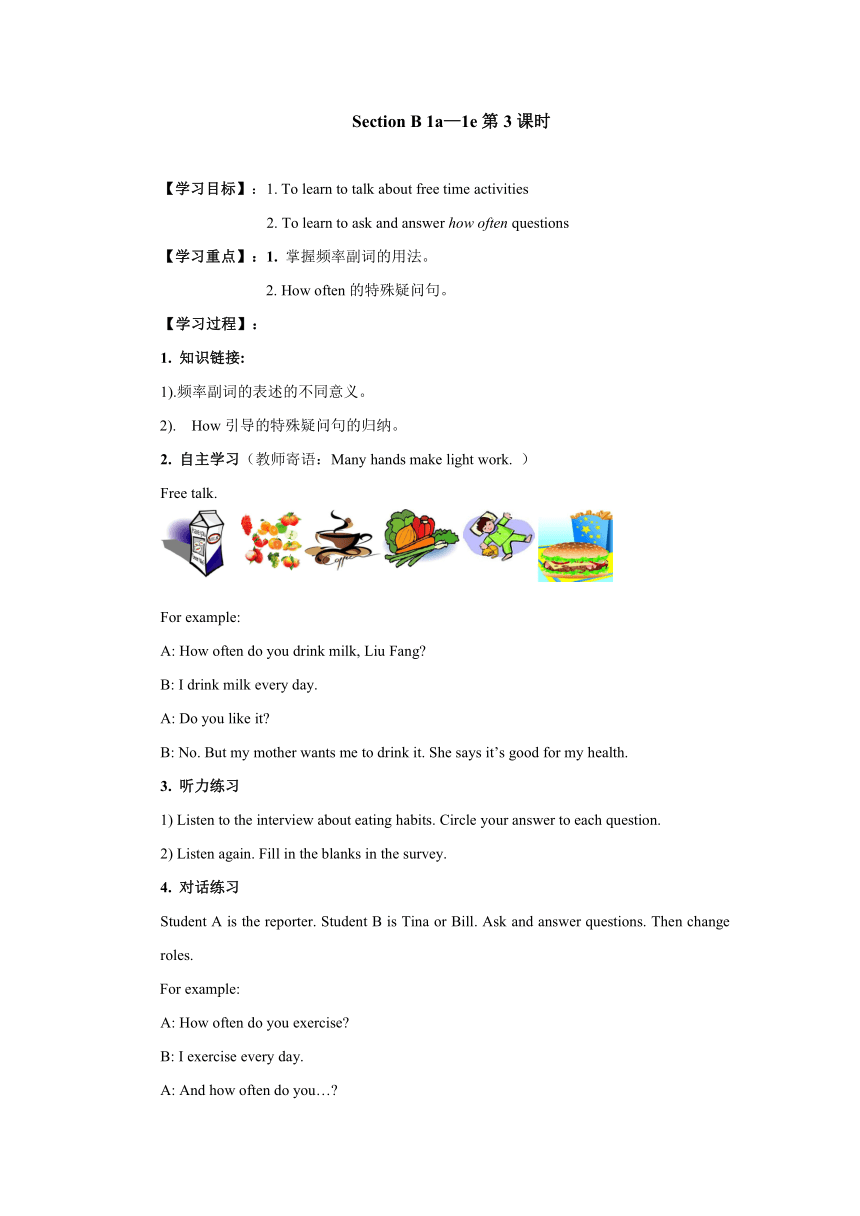Unit 2 How often do your exercise-Section B 1a—1e学案(无答案)
文档属性
| 名称 | Unit 2 How often do your exercise-Section B 1a—1e学案(无答案) |  | |
| 格式 | doc | ||
| 文件大小 | 515.0KB | ||
| 资源类型 | 教案 | ||
| 版本资源 | 人教新目标(Go for it)版 | ||
| 科目 | 英语 | ||
| 更新时间 | 2022-11-09 20:00:20 | ||
图片预览

文档简介
Section B 1a—1e第3课时
【学习目标】:1. To learn to talk about free time activities
2. To learn to ask and answer how often questions
【学习重点】:1. 掌握频率副词的用法。
2. How often的特殊疑问句。
【学习过程】:
1. 知识链接:
1).频率副词的表述的不同意义。
2). How引导的特殊疑问句的归纳。
2. 自主学习(教师寄语:Many hands make light work. )
Free talk.
For example:
A: How often do you drink milk, Liu Fang
B: I drink milk every day.
A: Do you like it
B: No. But my mother wants me to drink it. She says it’s good for my health.
3. 听力练习
1) Listen to the interview about eating habits. Circle your answer to each question.
2) Listen again. Fill in the blanks in the survey.
4. 对话练习
Student A is the reporter. Student B is Tina or Bill. Ask and answer questions. Then change roles.
For example:
A: How often do you exercise
B: I exercise every day.
A: And how often do you…
5. 小组活动
Ask students to discuss in groups. Fill in the chart and have a report.
Name vegetables fruit exercise
Maria every day every day four times a week
Who is the healthiest
Report :
In my group, I think Maria is the healthiest. Because her eating and exercise habits are pretty good. She exercises every day. She likes to play basketball. She eats vegetables every day.
课后作业
Fill in the blanks in the conversation.
A: What do Tom and Mike do on weekends
B: They sometimes go to the museum.
A: do they go to the shopping center
B: ever. Maybe about twice a month.
A: do they watch TV
B: Mike never watches TV, but Tom watches TV day.
A: Oh, I’m just like Tom. I watch TV, too.
【学习小结】(教师寄语:No man can do two things at once.)
1. 总结一下本课时学到的词汇。
2. 总结归纳一下How引导的特殊疑问句。
【达标检测】(教师寄语:Never do things by halves)
(1) There are only two boats in the river. (对划线部分提问)
__________ __________ boats are there in the river
(2) I waited for the bus for twenty minutes. (对划线部分提问)
__________ __________ did you wait for the bus
(3) His father never does the dishes. (对划线部分提问)
__________ __________ does his father do the dishes
【学后反思】(教师寄语:Never do things by halves)
通过本节课的学习我最大的收获:_______________________________
感到自己有待解惑:__________________________________________
PAGE
【学习目标】:1. To learn to talk about free time activities
2. To learn to ask and answer how often questions
【学习重点】:1. 掌握频率副词的用法。
2. How often的特殊疑问句。
【学习过程】:
1. 知识链接:
1).频率副词的表述的不同意义。
2). How引导的特殊疑问句的归纳。
2. 自主学习(教师寄语:Many hands make light work. )
Free talk.
For example:
A: How often do you drink milk, Liu Fang
B: I drink milk every day.
A: Do you like it
B: No. But my mother wants me to drink it. She says it’s good for my health.
3. 听力练习
1) Listen to the interview about eating habits. Circle your answer to each question.
2) Listen again. Fill in the blanks in the survey.
4. 对话练习
Student A is the reporter. Student B is Tina or Bill. Ask and answer questions. Then change roles.
For example:
A: How often do you exercise
B: I exercise every day.
A: And how often do you…
5. 小组活动
Ask students to discuss in groups. Fill in the chart and have a report.
Name vegetables fruit exercise
Maria every day every day four times a week
Who is the healthiest
Report :
In my group, I think Maria is the healthiest. Because her eating and exercise habits are pretty good. She exercises every day. She likes to play basketball. She eats vegetables every day.
课后作业
Fill in the blanks in the conversation.
A: What do Tom and Mike do on weekends
B: They sometimes go to the museum.
A: do they go to the shopping center
B: ever. Maybe about twice a month.
A: do they watch TV
B: Mike never watches TV, but Tom watches TV day.
A: Oh, I’m just like Tom. I watch TV, too.
【学习小结】(教师寄语:No man can do two things at once.)
1. 总结一下本课时学到的词汇。
2. 总结归纳一下How引导的特殊疑问句。
【达标检测】(教师寄语:Never do things by halves)
(1) There are only two boats in the river. (对划线部分提问)
__________ __________ boats are there in the river
(2) I waited for the bus for twenty minutes. (对划线部分提问)
__________ __________ did you wait for the bus
(3) His father never does the dishes. (对划线部分提问)
__________ __________ does his father do the dishes
【学后反思】(教师寄语:Never do things by halves)
通过本节课的学习我最大的收获:_______________________________
感到自己有待解惑:__________________________________________
PAGE
同课章节目录
- Unit 1 Where did you go on vacation?
- Section A
- Section B
- Unit 2 How often do you exercise?
- Section A
- Section B
- Unit 3 I'm more outgoing than my sister.
- Section A
- Section B
- Unit 4 What's the best movie theater?
- Section A
- Section B
- Unit 5 Do you want to watch a game show?
- Section A
- Section B
- Unit 6 I'm going to study computer science.
- Section A
- Section B
- Unit 7 Will people have robots?
- Section A
- Section B
- Unit 8 How do you make a banana milk shake?
- Section A
- Section B
- Unit 9 Can you come to my party?
- Section A
- Section B
- Unit 10 If you go to the party, you'll have a grea
- Section A
- Section B
